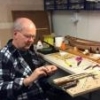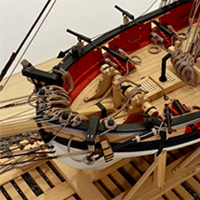-
Posts
314 -
Joined
-
Last visited
Reputation Activity
-
 Moxis got a reaction from mtaylor in second plank
Moxis got a reaction from mtaylor in second plank
You could use different shades of stain to "paint" the lengths of planks to have color change if you want.
-
 Moxis reacted to michael101 in second plank
Moxis reacted to michael101 in second plank
Thank you Moxis
interesting idea but maybe I will leave it in the same color and use the same method that you wrote before
-
 Moxis got a reaction from Kikatinalong in second plank
Moxis got a reaction from Kikatinalong in second plank
Hello Michael, would it work if you first prepare the full length plank so that it will fit completely into the hull, tapering the ends as necessary, and after that cut it into pieces of 127 mm length and glue them into the hull? This way you have the widths of plank ends to match with each other.
-
 Moxis reacted to michael101 in second plank
Moxis reacted to michael101 in second plank
Thank you Mtaylor,
yes i have read the tutorials but all of them taking about the first plank , and no one talk about the issue below
——————————
Thank you Moxis , that what though at the first , but a friend told me if i choose this method all the line will have the same color and the segments will no be show , but maybe i will pick this method if i will not find other solution
-
 Moxis got a reaction from mtaylor in second plank
Moxis got a reaction from mtaylor in second plank
Hello Michael, would it work if you first prepare the full length plank so that it will fit completely into the hull, tapering the ends as necessary, and after that cut it into pieces of 127 mm length and glue them into the hull? This way you have the widths of plank ends to match with each other.
-
 Moxis got a reaction from stuglo in second plank
Moxis got a reaction from stuglo in second plank
Hello Michael, would it work if you first prepare the full length plank so that it will fit completely into the hull, tapering the ends as necessary, and after that cut it into pieces of 127 mm length and glue them into the hull? This way you have the widths of plank ends to match with each other.
-
 Moxis got a reaction from nehemiah in My humble method of making strops for blocks
Moxis got a reaction from nehemiah in My humble method of making strops for blocks
There has been recently many methods shown to make strops around small blocks. When rigging the guns for my Le Cerf I needed a big number of small 3 mm double blocks. For making strops around these I made this simple fixture, which fullfilled it`s task quite reasonably.
First a simple construction was made of a piece of scrap wood and 2 mm plywood. Small pieces of 1 mm and 0,6 mm iron wire were glued into the bottom of the jig, and grooves were sawn with jeweler`s saw into the plywood walls:
Pieces of 0,15 mm thread were put into the first grooves, and blocks were positioned to the jig so that the 0,6 mm wire was put through one hole of the block:
Then small pieces of 0,6 mm rigging thread were placed into the second grooves:
And then it was rotated around the block and then around the 1 mm iron wire:
And now it remained only to make a small knot between the block and the 1 mm loop using the thinner thread, and attach small blops of diluted PVA glue into both ends of the block. After the glue had dried, ends of threads were cut as near as possible of the block.....
..... and blocks were ready......
......and used for rigging the guns:
-
 Moxis got a reaction from captain_hook in Attaching rope to blocks.
Moxis got a reaction from captain_hook in Attaching rope to blocks.
You might be interested about the jig I made to tie rope around a block:
-
 Moxis reacted to jwvolz in Attaching rope to blocks.
Moxis reacted to jwvolz in Attaching rope to blocks.
Here's an easy method and it is similar to how I do them, and the video is easier than me trying to explain it. Should give you the look you want.
A key aspect in my opinion is using finer diameter seizing thread than shown in the video to help keep things in scale.
https://www.youtube.com/watch?v=nzDl5MYOgmQ
-
 Moxis got a reaction from mtaylor in Attaching rope to blocks.
Moxis got a reaction from mtaylor in Attaching rope to blocks.
You might be interested about the jig I made to tie rope around a block:
-
 Moxis got a reaction from Gregory in Attaching rope to blocks.
Moxis got a reaction from Gregory in Attaching rope to blocks.
You might be interested about the jig I made to tie rope around a block:
-
 Moxis got a reaction from mtaylor in Planking the hull
Moxis got a reaction from mtaylor in Planking the hull
Thank you Chuck for wonderful videos about hull planking. I didn't believe it is so simple, but now I know better.
However I have one question: You said you use only CA glue to fasten the planks into bulkheads. Could you inform which brand of glue you are using? Because I have tried that too with different brands, but have not found any which would stick strongly enough. In fact they are not sticking at all perhaps due to the porosity of wood.
And I would love to see how you are planking the stern of the hull too, because normally there is no groove where to place the end of plank.
-
 Moxis got a reaction from bruce d in Planking the hull
Moxis got a reaction from bruce d in Planking the hull
Thank you Chuck for wonderful videos about hull planking. I didn't believe it is so simple, but now I know better.
However I have one question: You said you use only CA glue to fasten the planks into bulkheads. Could you inform which brand of glue you are using? Because I have tried that too with different brands, but have not found any which would stick strongly enough. In fact they are not sticking at all perhaps due to the porosity of wood.
And I would love to see how you are planking the stern of the hull too, because normally there is no groove where to place the end of plank.
-
 Moxis got a reaction from mtaylor in 1:48 boiler
Moxis got a reaction from mtaylor in 1:48 boiler
Very nice work hyw. I understand you have made a stove and a steam boiler to supply some sort of steam engine. Are you using etched brass parts for those miniature items?
-
 Moxis got a reaction from smtm2013 in How to fix copper/brass strips and fittings to hull or other surfaces?
Moxis got a reaction from smtm2013 in How to fix copper/brass strips and fittings to hull or other surfaces?
I have also found out that the 5 minutes Araldit does not always cure completely hard. That is why I have moved to use the 60 minutes Araldite which seems to work better.
-
 Moxis got a reaction from pontiachedmark in How to fix copper/brass strips and fittings to hull or other surfaces?
Moxis got a reaction from pontiachedmark in How to fix copper/brass strips and fittings to hull or other surfaces?
I have also found out that the 5 minutes Araldit does not always cure completely hard. That is why I have moved to use the 60 minutes Araldite which seems to work better.
-
 Moxis got a reaction from mtaylor in How to fix copper/brass strips and fittings to hull or other surfaces?
Moxis got a reaction from mtaylor in How to fix copper/brass strips and fittings to hull or other surfaces?
I have also found out that the 5 minutes Araldit does not always cure completely hard. That is why I have moved to use the 60 minutes Araldite which seems to work better.
-
 Moxis got a reaction from Duanelaker in Simple carving techniques for first-timers using a rotary tool and burrs
Moxis got a reaction from Duanelaker in Simple carving techniques for first-timers using a rotary tool and burrs
This is my first attempt with carving. As I said earlier, my new project needs some simple carvings at the stern. After having read all tutorials available, I chose to use rotating tools for this work, because it feels easier for me than to use knives and chisels and the quality of carvings might be better, at least for me with no previous experience.
So the first thing was to obtain suitable wood for this work. Having read from different sources that boxwood would be the best choice, I started to look for that. Soon I found out that this kind of wood couldn`t be found anywhere in this country. So I ordered a lump of good looking boxwood fron the supplier in the UK.
Next I thought to start from the most difficult thing, the letters for ship`s name. These are very small, about 3,5 mm high, and preferable made with old type font. Laser cutting was first tried with fonts found in Corel Draw. They were scaled and sent to laser cutting company, but results were not at all acceptable. It was not possible to have these small letters not to be burnt by the laser, and removing the unevitable char from them would have been almost impossible. So next I turned into my dear old cnc router, and after some testing and changes the results were improving until acceptable. Letters are cut from 0,6 mm thick boxwood, letter height is 3,6 mm and they were cut with dia. 0,3 mm cutter. The font was found from the CADCAM program`s (Vector) font library.
A nice picture of red deer was found in Internet, scaled down with Corel Draw and printed on paper. This was glued on 2 mm boxwood and cut with a jeweler`s saw, and edges rounded with the rotary tool, using old dentist`s cutting bits.
The remaining parts were also cut of 2 mm boxwood and "machined" with rotary tool.
Finally all parts were glued into the stern of the model and stained with light walnut color.
-
 Moxis got a reaction from IgorSky in Simple carving techniques for first-timers using a rotary tool and burrs
Moxis got a reaction from IgorSky in Simple carving techniques for first-timers using a rotary tool and burrs
This is my first attempt with carving. As I said earlier, my new project needs some simple carvings at the stern. After having read all tutorials available, I chose to use rotating tools for this work, because it feels easier for me than to use knives and chisels and the quality of carvings might be better, at least for me with no previous experience.
So the first thing was to obtain suitable wood for this work. Having read from different sources that boxwood would be the best choice, I started to look for that. Soon I found out that this kind of wood couldn`t be found anywhere in this country. So I ordered a lump of good looking boxwood fron the supplier in the UK.
Next I thought to start from the most difficult thing, the letters for ship`s name. These are very small, about 3,5 mm high, and preferable made with old type font. Laser cutting was first tried with fonts found in Corel Draw. They were scaled and sent to laser cutting company, but results were not at all acceptable. It was not possible to have these small letters not to be burnt by the laser, and removing the unevitable char from them would have been almost impossible. So next I turned into my dear old cnc router, and after some testing and changes the results were improving until acceptable. Letters are cut from 0,6 mm thick boxwood, letter height is 3,6 mm and they were cut with dia. 0,3 mm cutter. The font was found from the CADCAM program`s (Vector) font library.
A nice picture of red deer was found in Internet, scaled down with Corel Draw and printed on paper. This was glued on 2 mm boxwood and cut with a jeweler`s saw, and edges rounded with the rotary tool, using old dentist`s cutting bits.
The remaining parts were also cut of 2 mm boxwood and "machined" with rotary tool.
Finally all parts were glued into the stern of the model and stained with light walnut color.
-
 Moxis got a reaction from GrandpaPhil in Clara May by Moxis - FINISHED - 1/48 scale - ketch - after David McGregor plans
Moxis got a reaction from GrandpaPhil in Clara May by Moxis - FINISHED - 1/48 scale - ketch - after David McGregor plans
Finally I have made also the running rigging, so we could consider Clara May as ready.
The running rigging was made using Morope`s beige coloured 0,6 and 0,25 mm ropes. The task was not so difficult as I first thought, the only problem was to quess, where all the ropes shall be belayed because that was not shown on the plan. It may be that the pins I chose were not the right ones, but at least I am happy with them.
The sail were made of our old bed sheets. First the Admiral used her sewing skills and made all the seams and edges of sails. After that they were submerged into colouring bath made of different acrylic colour and little PVA glue. And after drying sails were cut into correct shape.
Last but not least I made a cradle for the model of 10 mm birch panel. Parts for it were sawn with bandsaw, sanded and stained with dark oak colour, then glued together and voila, there we were.
And now hard thinking what to build next, because I found that building wooden ship models is really a nice hobby for me.
-
 Moxis got a reaction from wefalck in Micrometer set screw for Proxxon FKS/E table saw
Moxis got a reaction from wefalck in Micrometer set screw for Proxxon FKS/E table saw
When working with my present project, I needed very accurate planks with even height. First I tried to set the fence of my Proxxon saw manually, but it is very frustrating to have it set within a few hundreds of a millimeter.
So i decided to make this small gadget to simplify the setting. The only thing what was needed was to mill two pieces of aluminium, and cut threads into them for set screw and locking screw. The thread of set screw is M6x1, so that one revolution extends the screw with one millimeter. The head of the screw has 10 divisions so that one division represents 0,1 mm movement. The set screw only pushes the fence, it is not threaded into it, which makes it easy to remove the gadget after the fence is set. With this equipment i can now easily adjust the width of planks in about 0,05 mm accuracy.
-
 Moxis got a reaction from thibaultron in Micrometer set screw for Proxxon FKS/E table saw
Moxis got a reaction from thibaultron in Micrometer set screw for Proxxon FKS/E table saw
That's true. First I thought to use M5x0.5 thread which would have given forward movement of 0.5 mm with one revolution. But then I thought it to be an overkill for what I needed. After all they are wooden planks which we are producing. A change of air moisture or temperature would have more effect on plank dimensions.
-
 Moxis got a reaction from druxey in Micrometer set screw for Proxxon FKS/E table saw
Moxis got a reaction from druxey in Micrometer set screw for Proxxon FKS/E table saw
That's true. First I thought to use M5x0.5 thread which would have given forward movement of 0.5 mm with one revolution. But then I thought it to be an overkill for what I needed. After all they are wooden planks which we are producing. A change of air moisture or temperature would have more effect on plank dimensions.
-
 Moxis got a reaction from druxey in Micrometer set screw for Proxxon FKS/E table saw
Moxis got a reaction from druxey in Micrometer set screw for Proxxon FKS/E table saw
When working with my present project, I needed very accurate planks with even height. First I tried to set the fence of my Proxxon saw manually, but it is very frustrating to have it set within a few hundreds of a millimeter.
So i decided to make this small gadget to simplify the setting. The only thing what was needed was to mill two pieces of aluminium, and cut threads into them for set screw and locking screw. The thread of set screw is M6x1, so that one revolution extends the screw with one millimeter. The head of the screw has 10 divisions so that one division represents 0,1 mm movement. The set screw only pushes the fence, it is not threaded into it, which makes it easy to remove the gadget after the fence is set. With this equipment i can now easily adjust the width of planks in about 0,05 mm accuracy.
-
 Moxis got a reaction from Canute in Micrometer set screw for Proxxon FKS/E table saw
Moxis got a reaction from Canute in Micrometer set screw for Proxxon FKS/E table saw
That's true. First I thought to use M5x0.5 thread which would have given forward movement of 0.5 mm with one revolution. But then I thought it to be an overkill for what I needed. After all they are wooden planks which we are producing. A change of air moisture or temperature would have more effect on plank dimensions.












